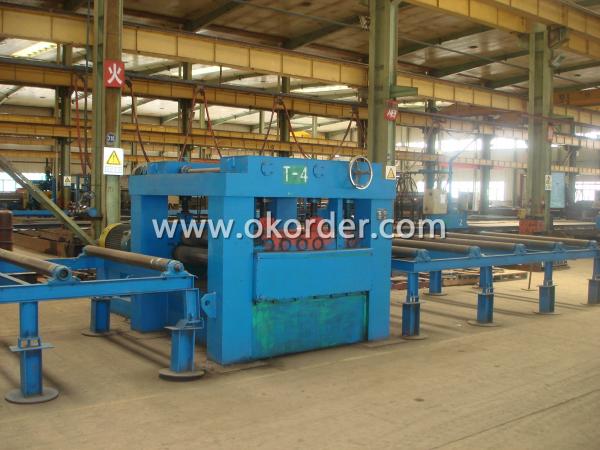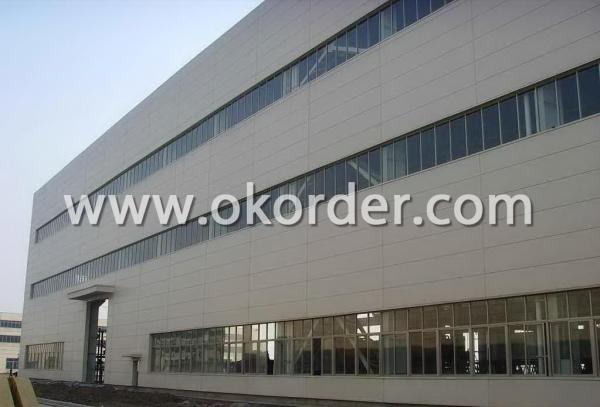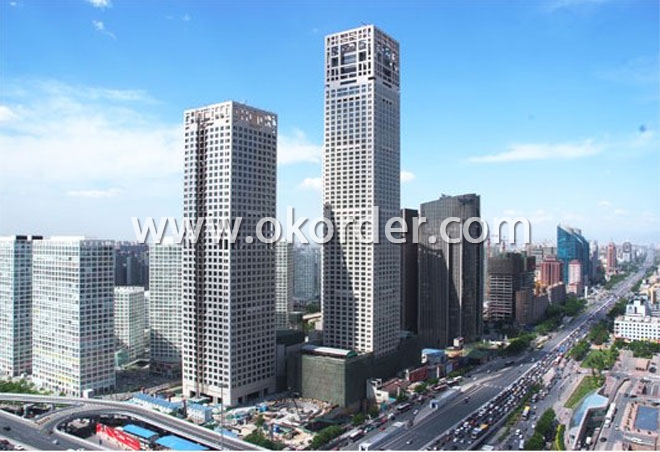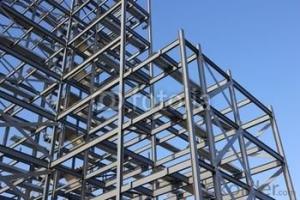High Quality Light Steel Workshop
- Loading Port:
- Nantong
- Payment Terms:
- TT OR LC
- Min Order Qty:
- -
- Supply Capability:
- 200000 m.t./month
OKorder Service Pledge
OKorder Financial Service
You Might Also Like
Technical support of light steel structure workshop
Worker | Rate of frontline workers with certificate on duty reaches 100% |
Welder | 186 welders got AWS & ASME qualification 124 welders got JIS qualification 56 welders got DNV &BV qualification |
Technical inspector | 40 inspectors with UT 2 certificate 10 inspectors with RT 2 certificate 12 inspectors with MT 2 certificate 3 inspectors with UT3 certificate |
Engineer | 21 engineers with senior title 49 engineers with medium title 70 engineers with primary title. 61 First-Class Construction Engineers 182 Second-Class Construction Engineers |
International certification | 10 engineers with International Welding engineer, 8 engineers with CWI. |
Production Flow of steel structure
Material preparation—cutting—fitting up—welding—component correction—rust removal—paint coating—packing—to storage and transportation (each process has the relevant inspection)
 |  |
*Characters of Structure Steel
1. Steel is characterized by high strength, light weight, good rigidity, strong deformation capacity, so it is suitable for construction of large-span, super high and super-heavy buildings particularly;
2. It with good homogeneous and isotropic, is an ideal elastomer which perfectly fits the application of general engineering;
3. The material has good ductility and toughness, so it can have large deformation and it can well withstand dynamic loads;
4. Steel structure’s construction period is short;
5. Steel structure has high degree of industrialization and can realize-specialized production with high level of mechanization.
*Steel structure application
1. Heavy industrial plants: relatively large span and column spacing; with a heavy duty crane or large-tonnage cranes; or plants with 2 to 3 layers cranes; as well as some high-temperature workshop should adopt steel crane beams, steel components, steel roof, steel columns, etc. up to the whole structure.

2. Large span structure: the greater the span of the structure, the more significant economic benefits will have by reducing the weight of the structure
3. Towering structures and high-rise buildings: the towering structure, including high-voltage transmission line towers, substation structure, radio and television emission towers and masts, etc. These structures are mainly exposed to the wind load. Besides of its light weight and easy installation, structure steel can bring upon with more economic returns by reducing the wind load through its high-strength and smaller member section.

4. Structure under dynamic loads: As steel with good dynamic performance and toughness, so it can be used directly to crane beam bearing a greater or larger span bridge crane
5. Removable and mobile structures: Structure Steel can also apply to movable Exhibition hall and prefabricated house etc by virtue of its light weight, bolt connection, easy installation and uninstallation. In case of construction machinery, it is a must to use structure steel so as to reduce the structural weight.
6. Containers and pipes: the high-pressure pipe and pipeline, gas tank and boiler are all made of steel for the sake of its high strength and leakproofness
7. Light steel structure: light steel structures and portal frame structure combined with single angle or thin-walled structural steel with the advantages of light weight, build fast and steel saving etc., in recent years has been widely used.
8. Other buildings: Transport Corridor, trestle and various pipeline support frame, as well as blast furnaces and boilers frameworks are usually made of steel structure.
All in all, according to the reality, structure steel is widely used for high, large, heavy and light construction.
- Q:How are steel structures designed to be resistant to seismic pounding?
- Steel structures are designed to be resistant to seismic pounding through various strategies. One common approach is to incorporate seismic isolation systems, such as base isolators or dampers, which absorb and dissipate the energy generated during an earthquake. These systems help to reduce the forces transmitted to the structure and minimize the potential for pounding. Additionally, steel structures are often designed with sufficient gaps or expansion joints to allow for relative movement between adjacent elements, thus preventing direct collisions and reducing the risk of pounding.
- Q:What is the role of steel in hotels and hospitality buildings?
- Due to its numerous advantages and properties, steel plays a crucial role in hotels and hospitality buildings. The strength and durability of steel make it an ideal choice for constructing large, multi-story structures like hotels. It can withstand heavy loads and resist external forces, ensuring the safety and structural integrity of the building. The versatility of steel allows for flexible and efficient design options, enabling architects and engineers to create unique and visually appealing hotel structures. Its high strength-to-weight ratio allows for spacious areas without the need for interior columns, enhancing the overall functionality of the building. This flexibility also allows for future modifications and expansions to meet changing market demands. In addition to its structural benefits, steel is fire-resistant, providing an added layer of safety in hospitality buildings. It does not burn, warp, or emit toxic fumes when exposed to fire, reducing the risk of damage and ensuring the safety of guests and staff. Steel's durability translates to reduced maintenance costs for hotels. It is resistant to corrosion and deterioration, resulting in a longer lifespan compared to other materials. This reduces the need for frequent repairs and replacements, saving hotels money in the long run. Furthermore, steel construction is known for its speed and efficiency. Off-site fabrication and on-site assembly allow for faster construction schedules, minimizing disruption to hotel operations and enabling them to generate revenue sooner. Lastly, steel's sustainability and eco-friendliness make it a desirable choice for hospitality buildings. It is recyclable and can be repurposed at the end of its lifespan, reducing the environmental impact. Additionally, the use of steel in construction requires fewer materials and produces less waste compared to traditional building methods, reducing the overall carbon footprint. In conclusion, steel's role in hotels and hospitality buildings encompasses strength, durability, versatility, fire-resistance, low maintenance requirements, speed of construction, and sustainability. These qualities make steel an essential component in creating safe, efficient, and visually appealing structures that can meet the needs of the ever-evolving hospitality industry.
- Q:What are the different finishes and coatings available for steel structures?
- There are several different finishes and coatings available for steel structures, including galvanized coatings, epoxy coatings, polyurethane coatings, and powder coatings. These finishes and coatings provide protection against corrosion, enhance durability, and improve the aesthetic appearance of steel structures.
- Q:What are the considerations for steel structure design in mountainous areas?
- When designing steel structures in mountainous areas, several considerations need to be taken into account. Firstly, the design should account for the dynamic loads that mountainous regions may experience, such as strong winds, heavy snowfall, and earthquakes. The structure needs to be able to withstand these forces and ensure the safety of the occupants. Additionally, the design should consider the topography and geology of the area. Mountainous terrains often have steep slopes and uneven ground, requiring suitable foundation design and anchorage techniques to ensure stability. Environmental factors should also be considered, such as temperature variations and exposure to extreme weather conditions. This may involve selecting appropriate materials and coatings that can withstand corrosion and erosion caused by harsh climates. Lastly, the design should take into account the accessibility and transportation challenges in mountainous areas. Construction materials, equipment, and maintenance access should be carefully planned to overcome logistical hurdles and ensure the feasibility of the project. Overall, the design of steel structures in mountainous areas requires careful consideration of dynamic loads, topography, environment, and accessibility to ensure a safe and durable construction.
- Q:What is the difference between a steel building and a steel stadium?
- The main difference between a steel building and a steel stadium lies in their purpose and scale. A steel building typically refers to a structure constructed primarily with steel framing, commonly used for commercial, industrial, or residential purposes. On the other hand, a steel stadium specifically denotes a large sports venue made predominantly of steel, designed to accommodate a significant number of spectators for sporting events or concerts. Steel stadiums are often characterized by their grand scale, complex architecture, and unique features such as retractable roofs or large seating capacities.
- Q:What are the common design considerations for steel pedestrian bridges?
- Some common design considerations for steel pedestrian bridges include load capacity, structural stability, durability, aesthetic appeal, accessibility, and ease of maintenance.
- Q:How are steel structures designed for recreational facilities such as sports stadiums and theme parks?
- Steel structures for recreational facilities such as sports stadiums and theme parks are designed using a combination of engineering principles, architectural requirements, and specific project needs. The design process begins with a thorough analysis of the site conditions, load requirements, and intended usage of the facility. Engineers then create a structural design that utilizes steel as the primary material due to its strength, durability, and versatility. Advanced computer modeling and simulation tools are employed to ensure the structural integrity and safety of the steel framework. Additionally, considerations are made for factors such as aesthetics, accessibility, functionality, and integration with other building systems. The design process involves collaboration among architects, engineers, and other professionals to create efficient, safe, and visually appealing steel structures for recreational facilities.
- Q:How are steel structures used in oil and gas facilities?
- Steel structures are extensively employed in the oil and gas industry due to their robustness, potency, and ability to withstand harsh environmental conditions. They play a pivotal role in supporting different components and equipment within these facilities. One of the primary uses of steel structures in oil and gas facilities is for constructing storage tanks. These tanks are utilized for storing crude oil, refined petroleum products, and natural gas. Steel provides the necessary strength and structural integrity to endure the immense pressure and weight of the stored substances, ensuring their safety and preventing any leakage. Additionally, steel structures are employed in the construction of offshore platforms and drilling rigs. Offshore platforms are typically situated in challenging marine environments, exposed to extreme weather and corrosive saltwater. Steel, particularly corrosion-resistant alloys, is the ideal material choice for these structures as it offers exceptional resistance to corrosion and provides the requisite strength to support drilling equipment and personnel. Moreover, steel structures are utilized for constructing pipelines and pipe racks in oil and gas facilities. Pipelines are used for transporting oil, gas, and other fluids over long distances. Steel pipes are renowned for their high strength-to-weight ratio, which makes them suitable for withstanding the internal pressure and external loads that pipelines are subjected to. Furthermore, steel structures are also employed for constructing support buildings, compressor stations, and various other infrastructure within oil and gas facilities. These structures offer a secure and reliable framework for equipment installation, maintenance, and operation. Overall, steel structures are indispensable in oil and gas facilities as they provide the necessary strength, durability, and resistance to environmental conditions required for the safe and efficient operation of these facilities.
- Q:What are the design considerations for steel data centers?
- When designing steel data centers, it is important to keep in mind several key design considerations: 1. Structural Integrity: Steel is renowned for its strength and durability, making it an excellent choice for constructing data centers. Designers must ensure that the steel framework can withstand extreme weather conditions, seismic activity, and other potential hazards in order to maintain the facility's structural integrity. 2. Thermal Management: Data centers generate a significant amount of heat from the operation of servers and other equipment. Efficient thermal management is crucial to prevent overheating and ensure optimal performance. Steel data centers should incorporate proper insulation, ventilation systems, and cooling mechanisms to maintain a stable and cool environment for the equipment. 3. Power Distribution: Reliable and efficient power distribution systems are essential for uninterrupted operation in data centers. Designers must consider the load capacity, redundancy, and backup power options, such as generators or uninterruptible power supply (UPS) systems. Steel data centers often require dedicated spaces for housing electrical equipment and cabling. 4. Scalability and Flexibility: Data centers need to be designed with scalability in mind to accommodate future growth and technological advancements. Steel structures allow for easy expansion and modifications, making it simpler to accommodate additional equipment or reconfigure the layout as needed. 5. Security: Data centers store sensitive information and require high-level security measures. Design considerations include access control systems, surveillance cameras, fire suppression systems, and physical barriers to prevent unauthorized access and protect against potential threats. 6. Connectivity: Robust connectivity is crucial for fast and reliable data transmission in data centers. Designers need to consider the routing and placement of network cables and fiber optic infrastructure to optimize connectivity within the facility. 7. Environmental Impact: Sustainable design practices should be taken into account when constructing steel data centers. Incorporating energy-efficient systems, green building materials, and renewable energy sources can help reduce the environmental impact and improve overall efficiency. 8. Maintenance and Accessibility: Designers must consider ease of maintenance and accessibility for equipment installation, repairs, and upgrades. Ample space, clear pathways, and proper cable management systems should be incorporated into the design to facilitate maintenance and ensure optimal performance. To summarize, the design considerations for steel data centers revolve around structural integrity, thermal management, power distribution, scalability, security, connectivity, environmental impact, and accessibility. Addressing these considerations enables designers to create high-performance and efficient data centers that meet the demands of modern technology.
- Q:What are the considerations for steel structure design in arctic climates?
- When designing steel structures for arctic climates, several key considerations must be taken into account. Firstly, the extreme cold temperatures can cause steel to become brittle, leading to reduced strength and potential structural failures. Therefore, the selection of appropriate steel grades with high ductility and toughness is crucial to ensure structural integrity. Secondly, the design should account for the significant temperature variations and thermal expansion and contraction of steel. This can be achieved by incorporating expansion joints and flexible connections to accommodate the steel's movement without inducing stress concentrations. Additionally, the design should address the effects of snow accumulation and ice formation. Adequate snow load calculations and proper detailing to prevent snow drifts and ice buildup are essential to maintain structural stability and prevent excessive loading. Moreover, the corrosive nature of Arctic environments, due to exposure to saltwater or chemicals used for de-icing, calls for robust corrosion protection measures. This may include selecting corrosion-resistant steel coatings or employing effective maintenance practices to mitigate the risk of corrosion and structural deterioration. Lastly, considerations for transportation and logistics in remote Arctic locations should also be factored into the design. The challenges of accessing construction sites and transporting heavy steel components in these harsh environments must be carefully planned and accounted for. In conclusion, the considerations for steel structure design in arctic climates encompass selecting appropriate steel grades, accommodating thermal expansion, addressing snow and ice loads, implementing corrosion protection measures, and accounting for logistical challenges.
1. Manufacturer Overview |
|
|---|---|
| Location | |
| Year Established | |
| Annual Output Value | |
| Main Markets | |
| Company Certifications | |
2. Manufacturer Certificates |
|
|---|---|
| a) Certification Name | |
| Range | |
| Reference | |
| Validity Period | |
3. Manufacturer Capability |
|
|---|---|
| a)Trade Capacity | |
| Nearest Port | |
| Export Percentage | |
| No.of Employees in Trade Department | |
| Language Spoken: | |
| b)Factory Information | |
| Factory Size: | |
| No. of Production Lines | |
| Contract Manufacturing | |
| Product Price Range | |
Send your message to us
High Quality Light Steel Workshop
- Loading Port:
- Nantong
- Payment Terms:
- TT OR LC
- Min Order Qty:
- -
- Supply Capability:
- 200000 m.t./month
OKorder Service Pledge
OKorder Financial Service
Similar products
New products
Hot products
Hot Searches
Related keywords




























